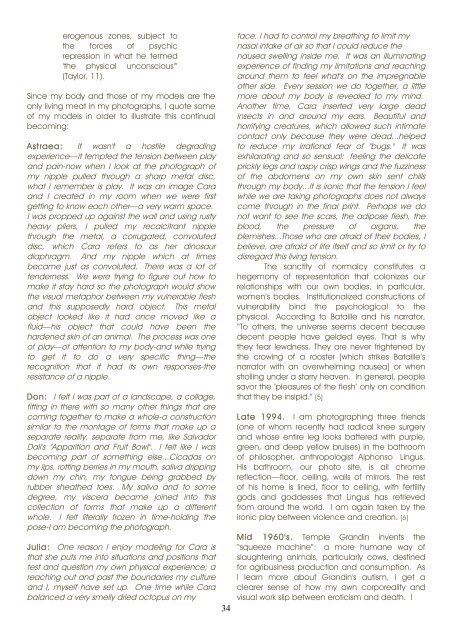Meet Animal Meat - Antennae The Journal of Nature in Visual Culture
Meet Animal Meat - Antennae The Journal of Nature in Visual Culture
Meet Animal Meat - Antennae The Journal of Nature in Visual Culture
Create successful ePaper yourself
Turn your PDF publications into a flip-book with our unique Google optimized e-Paper software.
erogenous zones, subject to<br />
the forces <strong>of</strong> psychic<br />
repression <strong>in</strong> what he termed<br />
'the physical unconscious'”<br />
(Taylor, 11).<br />
S<strong>in</strong>ce my body and those <strong>of</strong> my models are the<br />
only liv<strong>in</strong>g meat <strong>in</strong> my photographs, I quote some<br />
<strong>of</strong> my models <strong>in</strong> order to illustrate this cont<strong>in</strong>ual<br />
becom<strong>in</strong>g:<br />
Astraea: It wasn't a hostile degrad<strong>in</strong>g<br />
experience—it tempted the tension between play<br />
and pa<strong>in</strong>-now when I look at the photograph <strong>of</strong><br />
my nipple pulled through a sharp metal disc,<br />
what I remember is play. It was an image Cara<br />
and I created <strong>in</strong> my room when we were first<br />
gett<strong>in</strong>g to know each other—a very warm space.<br />
I was propped up aga<strong>in</strong>st the wall and us<strong>in</strong>g rusty<br />
heavy pliers, I pulled my recalcitrant nipple<br />
through the metal, a corrugated, convoluted<br />
disc, which Cara refers to as her d<strong>in</strong>osaur<br />
diaphragm. And my nipple which at times<br />
became just as convoluted. <strong>The</strong>re was a lot <strong>of</strong><br />
tenderness. We were try<strong>in</strong>g to figure out how to<br />
make it stay hard so the photograph would show<br />
the visual metaphor between my vulnerable flesh<br />
and this supposedly hard object. This metal<br />
object looked like it had once moved like a<br />
fluid—his object that could have been the<br />
hardened sk<strong>in</strong> <strong>of</strong> an animal. <strong>The</strong> process was one<br />
<strong>of</strong> play—<strong>of</strong> attention to my body-and while try<strong>in</strong>g<br />
to get it to do a very specific th<strong>in</strong>g—the<br />
recognition that it had its own responses-the<br />
resistance <strong>of</strong> a nipple.<br />
Don: I felt I was part <strong>of</strong> a landscape, a collage,<br />
fitt<strong>in</strong>g <strong>in</strong> there with so many other th<strong>in</strong>gs that are<br />
com<strong>in</strong>g together to make a whole-a construction<br />
similar to the montage <strong>of</strong> forms that make up a<br />
separate reality, separate from me, like Salvador<br />
Dali's "Apparition and Fruit Bowl". I felt like I was<br />
becom<strong>in</strong>g part <strong>of</strong> someth<strong>in</strong>g else...Cicadas on<br />
my lips, rott<strong>in</strong>g berries <strong>in</strong> my mouth, saliva dripp<strong>in</strong>g<br />
down my ch<strong>in</strong>, my tongue be<strong>in</strong>g grabbed by<br />
rubber sheathed toes. My saliva and to some<br />
degree, my viscera became jo<strong>in</strong>ed <strong>in</strong>to this<br />
collection <strong>of</strong> forms that make up a different<br />
whole. I felt literally frozen <strong>in</strong> time-hold<strong>in</strong>g the<br />
pose-I am becom<strong>in</strong>g the photograph.<br />
Julia: One reason I enjoy model<strong>in</strong>g for Cara is<br />
that she puts me <strong>in</strong>to situations and positions that<br />
test and question my own physical experience; a<br />
reach<strong>in</strong>g out and past the boundaries my culture<br />
and I, myself have set up. One time while Cara<br />
balanced a very smelly dried octopus on my<br />
34<br />
face, I had to control my breath<strong>in</strong>g to limit my<br />
nasal <strong>in</strong>take <strong>of</strong> air so that I could reduce the<br />
nausea swell<strong>in</strong>g <strong>in</strong>side me. It was an illum<strong>in</strong>at<strong>in</strong>g<br />
experience <strong>of</strong> f<strong>in</strong>d<strong>in</strong>g my limitations and reach<strong>in</strong>g<br />
around them to feel what's on the impregnable<br />
other side. Every session we do together, a little<br />
more about my body is revealed to my m<strong>in</strong>d.<br />
Another time, Cara <strong>in</strong>serted very large dead<br />
<strong>in</strong>sects <strong>in</strong> and around my ears. Beautiful and<br />
horrify<strong>in</strong>g creatures, which allowed such <strong>in</strong>timate<br />
contact only because they were dead...helped<br />
to reduce my irrational fear <strong>of</strong> "bugs." It was<br />
exhilarat<strong>in</strong>g and so sensual: feel<strong>in</strong>g the delicate<br />
prickly legs and raspy crisp w<strong>in</strong>gs and the fuzz<strong>in</strong>ess<br />
<strong>of</strong> the abdomens on my own sk<strong>in</strong> sent chills<br />
through my body...It is ironic that the tension I feel<br />
while we are tak<strong>in</strong>g photographs does not always<br />
come through <strong>in</strong> the f<strong>in</strong>al pr<strong>in</strong>t. Perhaps we do<br />
not want to see the scars, the adipose flesh, the<br />
blood, the pressure <strong>of</strong> organs, the<br />
blemishes...Those who are afraid <strong>of</strong> their bodies, I<br />
believe, are afraid <strong>of</strong> life itself and so limit or try to<br />
disregard this liv<strong>in</strong>g tension.<br />
<strong>The</strong> sanctity <strong>of</strong> normalcy constitutes a<br />
hegemony <strong>of</strong> representation that colonizes our<br />
relationships with our own bodies, <strong>in</strong> particular,<br />
women’s bodies. Institutionalized constructions <strong>of</strong><br />
vulnerability b<strong>in</strong>d the psychological to the<br />
physical. Accord<strong>in</strong>g to Bataille and his narrator,<br />
“To others, the universe seems decent because<br />
decent people have gelded eyes. That is why<br />
they fear lewdness. <strong>The</strong>y are never frightened by<br />
the crow<strong>in</strong>g <strong>of</strong> a rooster [which strikes Bataille’s<br />
narrator with an overwhelm<strong>in</strong>g nausea] or when<br />
stroll<strong>in</strong>g under a starry heaven. In general, people<br />
savor the ‘pleasures <strong>of</strong> the flesh’ only on condition<br />
that they be <strong>in</strong>sipid.” [5]<br />
Late 1994. I am photograph<strong>in</strong>g three friends<br />
(one <strong>of</strong> whom recently had radical knee surgery<br />
and whose entire leg looks battered with purple,<br />
green, and deep yellow bruises) <strong>in</strong> the bathroom<br />
<strong>of</strong> philosopher, anthropologist Alphonso L<strong>in</strong>gus.<br />
His bathroom, our photo site, is all chrome<br />
reflection—floor, ceil<strong>in</strong>g, walls <strong>of</strong> mirrors. <strong>The</strong> rest<br />
<strong>of</strong> his home is l<strong>in</strong>ed, floor to ceil<strong>in</strong>g, with fertility<br />
gods and goddesses that L<strong>in</strong>gus has retrieved<br />
from around the world. I am aga<strong>in</strong> taken by the<br />
ironic play between violence and creation. [6]<br />
Mid 1960's. Temple Grand<strong>in</strong> <strong>in</strong>vents the<br />
“squeeze mach<strong>in</strong>e”: a more humane way <strong>of</strong><br />
slaughter<strong>in</strong>g animals, particularly cows, dest<strong>in</strong>ed<br />
for agribus<strong>in</strong>ess production and consumption. As<br />
I learn more about Grand<strong>in</strong>'s autism, I get a<br />
clearer sense <strong>of</strong> how my own corporeality and<br />
visual work slip between eroticism and death. I












